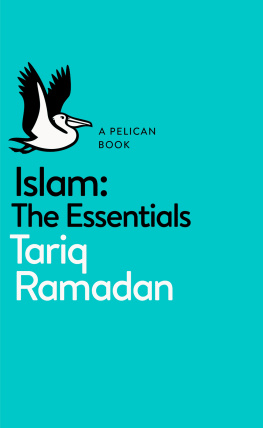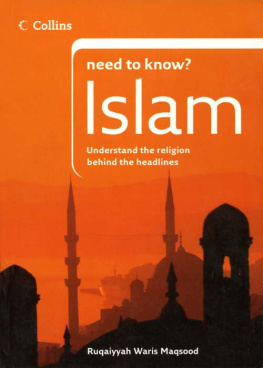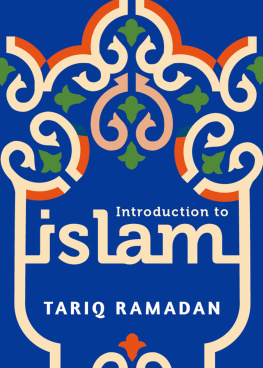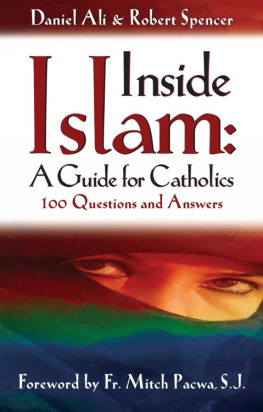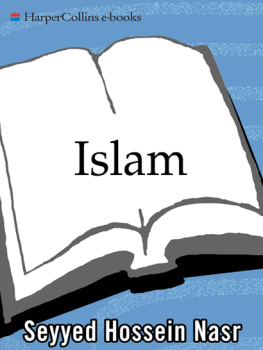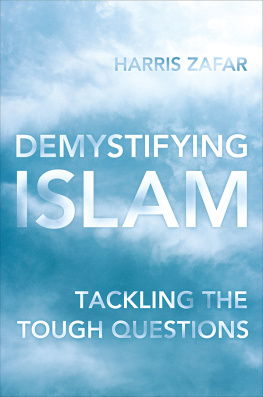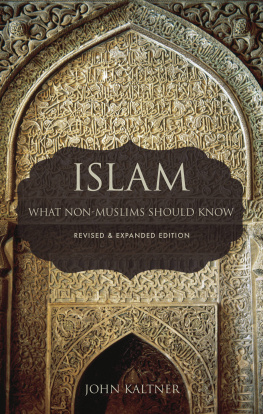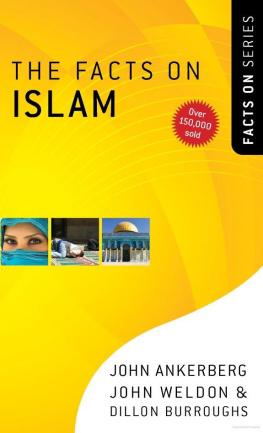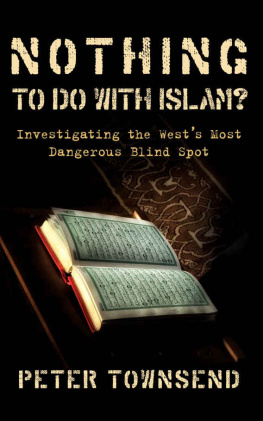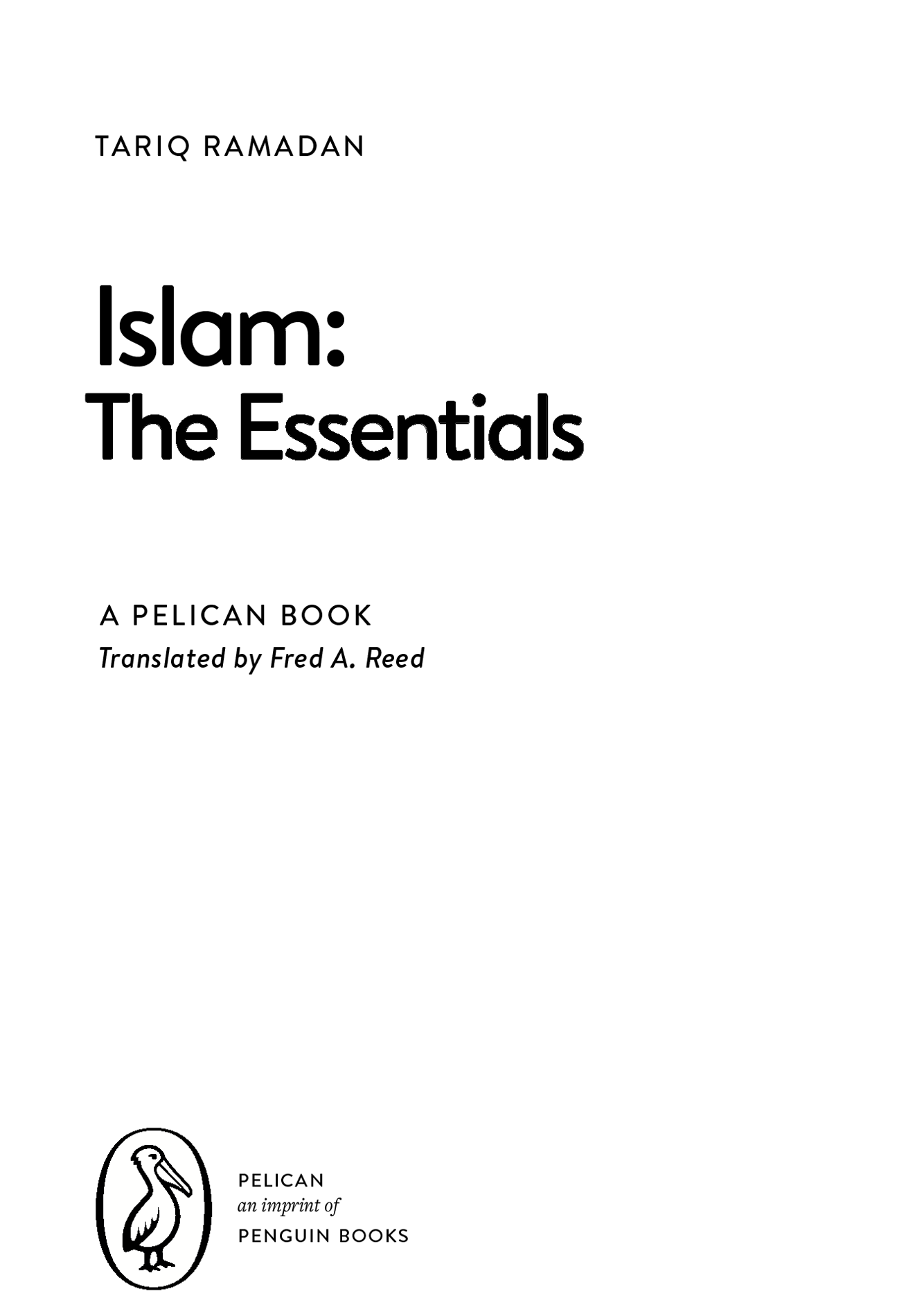PELICAN BOOKS
UK | USA | Canada | Ireland | Australia
India | New Zealand | South Africa
Penguin Books is part of the Penguin Random House group of companies whose addresses can be found at global.penguinrandomhouse.com .
First published 2017
Text copyright Tariq Ramadan, 2017
Translator copyright Fred A. Reed, 2017
The moral right of the author has been asserted
Book design by Matthew Young
ISBN: 978-0-141-98051-5
For Caroline,
with all my gratitude and
boundless respect
Acknowledgments
Achieving simplicity proved to be anything but simple. This book an initiation into Islam was intended to be accessible and concise. Little did I realize the effort involved in making it so! In finished form at last, it represents the synthesis of lectures, studies and essays too numerous to mention, and of actual experience gained over the years as a student, as a teacher, a scholar and thinker deeply involved both in public debate and at the grass-roots. These are the major factors, combined with the contributions of so many women and men encountered along the way Muslims, believers of other confessions or without any particular confession that have given me the impetus and the strength to write. My debt to them constitutes the guiding spirit of this short introductory volume.
First and foremost, I would like to thank Penguin Books, and particularly Helen Conford, for her confidence, her trust, her kindness and her friendship. Her commitment has proven immeasurable. My warmest and most fraternal thoughts go to Cynthia Read, who has accompanied me for so long with heart, attention and professional discipline. Deepest thanks, as well, go to my friend and translator Fred A. Reed for his contribution and his devotion despite the years of tight deadlines and an often-trying work schedule. Finally, a word of thanks to Drew Anderla, Shoaib Rokadiya and Annabel Huxley: each has contributed, in their respective fields, to the conception and distribution of this book. To all: the work of writing would be for naught without your clear-eyed and fine-tuned professional collaboration.
This book, in its present form, would never have seen the light of day without the contribution of Caroline Davis, my assistant and Program Manager at Oxford University: a woman of heart and of principle, and a model of great professionalism and deep humanity. To her I respectfully dedicate this work. Jennifer Reghoui, who managed my European office for five years, was unfailing in her support. My dear and supportive colleagues at the Middle East Centre at St Anthonys College, University of Oxford: Eugene Rogan, Walter Armbrust, Michael Willis, Laurent Mignon, Toby Matthiesen, Philip Robins and Avi Shlaim. Walaa Quisay, one of my doctorate students, for her conscientious research assistance. The entire team of the Research Center for Islamic Legislation and Ethics that has stood by me for four years will find in these pages ample reminders of our animated discussions. My profound gratitude goes to each and every one of you.
For Iman, always and intensely. For Maryam, Sami, Moussa and Najma with a fathers heart. For Shaima and Ali, with love. And, multiplying that same love today, for Kylian, Noor, Amin and the others soon to come, God willing. How much I owe you all! Nor can I ever forget my mother, to whom my debt is so great, may God protect her; my father, may Gods grace be upon him; and Aymen, Bilal, Yasser, Arwa, Hani, my sister and my brothers. May their children and our children explore the high road and the byways of the great journey with hope and conviction. And may that journey always be one of beauty.
My thanks, my true and deepest thanks.
Oxford, November 2016
Introduction
Hardly a day goes by without some mention of Islam. And yet many people, if pressed, will admit that they know very little about the religion of one quarter of the human race. We hear much talk of violence, terrorism, the status of women and slavery. Muslims are frequently pressured to provide answers and to justify what Islam is not. Yet there is very little space in society or in the media for an exploration and an explanation of what Islam genuinely is.
Hence the objective of this short book: to introduce readers in the simplest, most direct and the most thorough manner to Islam to its principles, its rituals, its history, its diversity and its evolution, not forgetting the numerous challenges facing Muslims today.
Tackling an entire religion and civilization requires some mental preparation. The Islamic universe is no less complex than that of Hinduism, of Buddhism, of Judaism or Christianity. The basic texts can be abstruse and their interpretation widely divergent and often contradictory; Islams schools of thought and its cultures do not always facilitate access to its essence as a world religion.
Before venturing into a belief system that possesses its own well-established principles, an inner coherence, and a distinct conception of humanity, life and death, readers may wish to put aside their preconceived notions and open their minds to something that may strike them as both familiar and strange. Islam comes complete with its own sacred texts, a system of references, eternal principles and applications to daily life; as such, religious, historical and legal knowledge is needed to understand its nature, its historical development and the challenges confronting it today.
For many readers, this journey of discovery will require both curiosity and effort. But it will also require intellectual humility as the path unfolds before us; a willingness to reconsider opinions often presented as established fact, to overcome stubborn prejudices and to suspend judgement for the duration of our voyage together. As we progress, these considerations will take on prime importance, for they will enable us to join the debate over key issues and to begin a process of critical reflection that is so sorely needed today, free of knee-jerk reactions, fears or attempts to justify the unjustifiable.
Written to be as accessible as possible, this brief introduction to the essence of Islam assumes no specialized knowledge on the readers part. It is designed to guide readers into the complexity of the multifaceted world of Islam as a religion and a civilization. The presents an introduction to the history of Islam, beginning with the Prophet Muhammad and the Revelation of the Quran, the prophetic mission and the basic elements of the Islamic Message, followed by a rapid survey of the evolution of the religion after the death of the Prophet Muhammad, the great schism between Sunni and Shia and the creation of the great introduces the concept of sharia the Way with its multitude of definitions and priorities, with the forms of jihad and the primacy of social action. The final chapter takes up the multitude of challenges facing todays Muslims, both in societies where they form the majority and those in which they are in the minority.
Each chapter is divided into short sections, making it easy for the reader to locate a specific subject or theme and to find there a concise and easily understandable explanation. The presentation is never strictly theoretical: each section first takes up the governing principle, then examines the diversity of interpretation and even the contradictions between declared principles and their application by Muslims down through history to the present day.

